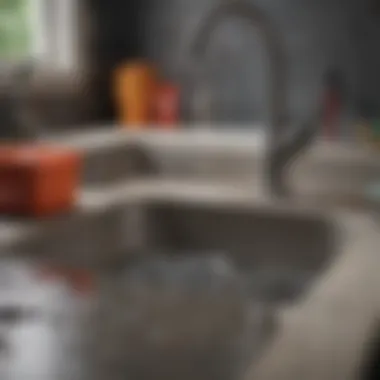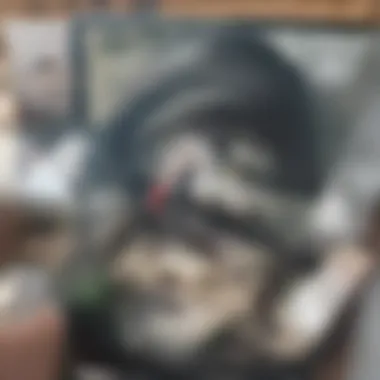Effective Strategies for Unclogging Your Garbage Disposal


Intro
Dealing with a clogged garbage disposal drain is a common issue for many homeowners. When there's standing water in the sink, it can be frustrating and inconvenient. Understanding how to approach this problem is crucial. This article aims to provide a comprehensive understanding of why clogs occur, how to fix them, and ways to prevent future issues.
Common Causes of Clogs
Before moving on to solutions, it is important to recognize the causes that lead to persistent standing water in your garbage disposal. Here are some well-known contributors:
- Food Waste Buildup: Over time, food particles can accumulate in the pipes, causing a blockage.
- Grease Accumulation: Pouring grease down the sink can create a significant clog as it hardens over time.
- Foreign Objects: Sometimes, small items accidentally get caught in the disposal, leading to problems.
- Drainage System Issues: Issues within the plumbing system can also cause standing water in the sink.
Identifying the cause of the clog is the first step towards effective problem-solving.
Step-by-Step Solutions for Unclogging
Once you understand what might be causing your garbage disposal to malfunction, you can proceed to unclog it. Here are some effective methods:
- Check the Power: First, ensure that the garbage disposal is plugged in and powered on. If it is not functioning at all, there may be a problem with the electrical supply.
- Use the Reset Button: Most disposals have a reset button on the bottom. Pressing this may help resolve minor issues.
- Manual Disengagement: You can manually turn the blades by using an Allen wrench. Insert it into the socket at the bottom of the disposal to turn the motor manually. This may free up any jammed objects.
- Use Water: Turn on the hot water and let it run for a few minutes to help dissolve some of the grease and food buildup.
- Plumber's Snake: If the clog persists, using a plumber's snake can help dislodge the blockage deeper in the pipes.
- Chemical Drain Cleaner: As a last resort, a chemical drain cleaner may be effective, but it should be used with caution as it can damage your plumbing.
Preventative Measures
After resolving the standing water issue, it is important to implement procedures to prevent clogging in the future. Here are some tips:
- Only Dispose of Food Waste: Avoid putting fibrous or starchy foods such as potatoes or celery into the disposal.
- Run Water: Always run cold water for 15-30 seconds after using the disposal to ensure everything is flushed through properly.
- Regular Maintenance: Periodically check for issues and clean the disposal by grinding ice cubes and citrus peels to keep it fresh.
When to Seek Professional Assistance
Sometimes, issues may go beyond simple unclogging. If the standing water persists after multiple attempts, it may indicate a more serious problem in your plumbing. Signs that you should call a professional include:
- Frequent clogs even after following recommended procedures.
- Unusual noises coming from the disposal.
- Water pooling around the disposal.
Don't hesitate to reach out to a qualified plumber for inspections and repairs when necessary. This proactive approach can save you from significant plumbing issues in the long run.
An understanding of your garbage disposal system and the potential problems tied to it is instrumental. With this guide, you should feel more confident in managing clogs and maintaining a functional kitchen plumbing system.
Understanding Garbage Disposal Systems
Garbage disposal systems are often an underappreciated yet crucial feature of modern kitchens. They simplify food waste management, preventing unpleasant odors from accumulating in trash cans and thus maintaining a cleaner and healthier environment. Understanding how these systems function and their individual components can significantly enhance a homeowner's ability to troubleshoot and address problems when they arise, including those irritating instances of standing water.
Having a clear grasp of garbage disposal systems allows homeowners to tackle issues effectively, decreasing reliance on professional plumbers for minor problems. Being informed about the specific mechanisms behind these appliances can foster proactive maintenance and a better understanding of when professional help is required.
Components of a Garbage Disposal
Garbage disposals are composed of several key components that work harmoniously to grind food waste effectively. The main elements include:
- Motor: The powerhouse of the system, typically located at the bottom, providing the necessary torque to turn the grinding chamber.
- Grinding Chamber: This is where food waste enters and is ground into smaller particles, allowing it to be easily washed down the drain.
- Impellers: These blades help to push food waste into the grinding mechanism while minimizing plant material blocking the drain.
- Discharge Tube: Once the food waste is ground, this tube directs it toward the sink's drainage system.
- Reset Button: This is a safety feature, allowing users to restart the unit after a jam occurs or the motor overheats.
Each of these components plays a vital role in ensuring the disposal functions properly. By understanding these parts, a homeowner can identify areas that may be malfunctioning, which aids in assessing the problem at hand.


How Garbage Disposal Works
The operation of a garbage disposal system is relatively straightforward but relies heavily on the interplay between its components. When food waste is introduced into the disposal, the following process typically unfolds:
- Activation: The user activates the disposal using a switch, which powers the motor.
- Grinding Process: The motor spins the impellers and blades rapidly, breaking down the food waste into smaller particles. This action can prevent clogs in the plumbing.
- Discharge: The ground food waste is forced out through the discharge tube and sent down the drain, ideally joined by a flow of water to help flush the waste away.
- Safety Checks: If the motor encounters a blockage, the reset button allows for a restart, and if it overheats, the system shuts down automatically to prevent damage.
Understanding this process can help individuals troubleshoot issues. Recognizing how each component aids in the grinding and flow of waste can reveal where problems may be occurring, especially when standing water indicates a clog or malfunction.
Identifying the Problem
When dealing with a garbage disposal that has standing water, the first step is understanding the problem at hand. Identifying the issue effectively can save time and prevent further complications down the line. Recognizing signs of a clogged drain and understanding its causes are essential steps that guide homeowners toward effective solutions. Moreover, addressing the problem early can help to mitigate damage that could arise from prolonged clogs. This awareness not only enhances the effectiveness of unclogging efforts but also promotes better maintenance of kitchen plumbing in the future.
Signs of a Clogged Drain
There are several clear indications that your garbage disposal is experiencing a clog. Common signs include:
- Standing Water: The most obvious sign. When water pools in your sink and does not drain, it indicates an obstruction in the disposal or draining system.
- Unpleasant Odors: A bad smell can originate from food debris that is trapped, signaling an inability for waste to properly flush away.
- Gurgling Noises: If you hear strange sounds from the disposal, this could mean air is trapped in the pipes, a common symptom of a clog.
- Slow Draining: If water takes longer than usual to drain, it may be a result of a narrowing passage caused by debris buildup.
Recognizing these signs early on helps to tackle the issue before it worsens and requires more intensive intervention.
Common Causes of Clogs
Understanding what causes clogs can aid in prevention and effective resolution. Common culprits include:
- Hard Food Scraps: Items like bones, large pieces of food, and fibrous materials can easily cause blockages.
- Grease and Oil: Pouring fats down the sink can lead to buildup in pipes over time, causing significant clogs.
- Foreign Objects: Sometimes, non-food items like utensils or small kitchen tools get lodged in the disposal.
- Vegetable Peels: These can create a dense mass that’s difficult for the disposal to handle.
By knowing these factors, homeowners can manage the disposal better and reduce the likelihood of future clogs.
Assessing Standing Water
Once you’ve identified signs and potential causes of a clogged drain, it’s time to assess the standing water directly. Begin by checking:
- Water Level: Is the water deep? This can show how severe the clog is. If it’s not draining at all, more action may be needed.
- Clarity of Water: If the water appears murky or discolored, this can indicate the presence of food remnants or other materials causing blockages.
- Odor: As previously mentioned, a foul smell may signal organic waste is trapped. This assessment guides which cleaning method you might choose.
Assessing standing water not only provides insight into how to proceed but also highlights the urgency of resolving the issue promptly.
Preparing for the Unclogging Process
Before delving into the intricacies of unclogging a garbage disposal drain, it is essential to prepare adequately. This phase is crucial, as it sets the stage for an efficient and effective unclogging process. Being well-equipped with the right tools and taking necessary safety precautions not only simplify the task but also help avoid potential hazards. Without proper preparation, the process may become tedious, prolonging the issue and possibly leading to more significant problems.
Essential Tools and Materials
When preparing to unclog the garbage disposal drain, having the right tools on hand is vital. Here’s a concise list of what you should gather:
- Plunger: A simple yet effective tool for dislodging clogs. A flat-bottomed plunger is ideal for this task.
- Baking Soda: This common household item is useful for cleaning and deodorizing.
- Vinegar: Often used in tandem with baking soda, vinegar can help break down grease and food particles.
- Plumbing Snake: This handy tool can reach deep clogs that other methods might miss.
- Dish Soap: A good lubricant that can aid in loosening clogs.
- Hot Water: Vital for flushing out remaining debris once clogs are dislodged.
In addition to these primary tools, it may be beneficial to have rubber gloves and a bucket. Gloves protect your hands from grease and bacteria, while a bucket can catch any water that may spill during the process.
Safety Precautions


Safety should be a top priority when attempting to unclog a garbage disposal. Here are several precautions to consider:
- Disconnect Power: Before starting any work, make sure the disposal is unplugged or the circuit breaker is turned off. This prevents accidents while working on the unit.
- Wear Gloves: Always wear rubber gloves to protect your hands from potential cuts or exposure to contaminants.
- Use Appropriate Tools: Employ tools for their intended purpose. Avoid using sharp objects to dislodge a clog, as this can damage the disposal.
- Follow Instructions: If you are using store-bought cleaners or tools, read the instructions carefully. Misuse can exacerbate the clog or damage the unit.
- Keep Children Away: Ensure children and pets are kept at a safe distance during the unclogging process to prevent accidents.
Preparation is more than just gathering supplies; it is about creating a safe environment for the unclogging task ahead. Ignoring these preparatory steps could lead to mishaps that complicate an already frustrating situation.
Methodical Unclogging Techniques
Understanding how to effectively unclog a garbage disposal drain is critical for homeowners. Standing water can often signal deeper issues that, if left unchecked, can lead to more significant plumbing problems. By employing methodical unclogging techniques, one can not only address the immediate issue but also reduce the risk of future clogs. These steps are essential for maintaining hygiene and functionality in a kitchen environment.
Manual Inspection and Cleaning
The first step in unclogging your garbage disposal should always involve a manual inspection. Before starting, ensure the disposal is turned off to prevent accidental injuries.
- Inspect the Disposal: Look for visible signs of blockage, like food debris or foreign objects that may be hindering its operation.
- Clean the Blades: Use tongs or a similar tool to remove any stuck debris. Never use your hands to reach into the disposal, as this presents a safety risk.
- Check the Splash Guard: The rubber splash guard can accumulate grime. Clean it thoroughly to prevent bad odors and ensure food has an easy passage into the disposal.
This step may seem trivial, but a thorough manual cleaning often resolves minor issues without resorting to more aggressive methods.
Using a Plunger
If manual cleaning does not resolve the standing water issue, using a plunger is a next good step. A plunger can create the suction needed to dislodge a clog. Here’s how to do it effectively:
- Use the Correct Plunger: A flange plunger is more effective for sink drains than a cup plunger.
- Create a Seal: Position the plunger over the disposal’s drain and ensure it seals well.
- Plunge Firmly: Apply strong, consistent force. This action can help create pressure that may dislodge a clog.
Applying Baking Soda and Vinegar
Baking soda and vinegar can serve as an eco-friendly solution to minor clogs.
- Pour Baking Soda: Start by adding a half cup of baking soda into the disposal.
- Add Vinegar: Follow this with half a cup of vinegar.
- Seal the Drain: Wait for about 15 minutes to allow the reaction to work on the clog.
- Flush with Water: After waiting, flush it out with hot water.
This method utilizes a chemical reaction to help break up food particles and grime, which can alleviate minor clogs.
Utilizing a Plumbing Snake
If the previous methods fail, a plumbing snake can reach deeper clogs. A plumbing snake is a flexible auger designed to break up or retrieve blockages. Here’s how to use one:
- Insert the Snake: Gently push the snake into the disposal's drain. Rotate it while pushing to break through any blockage.
- Pull Out Debris: If you feel resistance, pull back slightly and rotate again. This may help to dislodge the clog.
- Remove the Snake: Once you feel the blockage has cleared, carefully pull out the snake, ensuring not to leave any debris behind.
Flushing with Hot Water
After performing one or more of the above methods, flushing the disposal with hot water can be beneficial. Hot water helps to dissolve any remaining grease or food particles. Here’s how to do it:
- Boil Water: Heat a kettle full of water.
- Flush the Disposal: Slowly pour the hot water down the drain.
This final step can help ensure that the pathway is completely clear, preventing future issues.
Remember, maintaining your garbage disposal through regular cleaning and mindful usage can prolong its life and prevent clogs.


In summary, employing methodical unclogging techniques equips homeowners with practical skills to tackle the common issue of clogs in garbage disposals. Each step, from manual cleaning to flushing, plays a role in maintaining the efficiency of kitchen plumbing.
Preventative Measures for Future Clogs
Preventative measures are vital in maintaining the proper functionality of your garbage disposal. Taking proactive steps can help avoid the inconvenience and frustration that come with a clogged disposal. Awareness of usage guidelines and establishing regular maintenance routines are essential aspects that directly contribute to preventing clogs.
Proper Usage Guidelines
Understanding how to use your garbage disposal correctly reduces the risk of clogs. Here are some responsible usage practices:
- Limit Food Waste: Avoid putting large quantities of food down the disposal at once. It is advisable to feed it small amounts gradually. This prevents the system from becoming overwhelmed.
- Avoid Fibrous Materials: Do not dispose of fibrous foods like celery, onion skins, or corn husks. These materials can wrap around blades and create blockages.
- No Grease or Oils: Grease may seem liquid when you pour it, but it can solidify and create bocks. This includes fats from meat, cooking oils, and dairy products. Dispose of these in the trash instead.
- Hard Objects: It is important to never place hard items such as bones or shells in the disposal. These can damage the blades and cause serious clogs.
- Use Water: Always run cold water while using the disposal. This helps to wash food particles down effectively and keeps the system cleaner.
Following these guidelines is crucial to ensuring prolonged functionality and effectively avoiding clogs.
Regular Maintenance Routines
Regular maintenance allows for the optimal performance of your disposal system. Establishing a routine can help you identify issues before they escalate. Consider the following maintenance practices:
- Daily Usage: Utilize your garbage disposal regularly. This helps keep items flowing through the system, avoiding stagnation.
- Monthly Cleaning: Schedule a monthly cleaning. You can grind ice cubes mixed with salt to help sharpen the blades and remove debris.
- Baking Soda and Vinegar: Execute a monthly treatment by pouring half a cup of baking soda followed by a cup of vinegar. Allow it to fizz for a few minutes, then rinse with hot water.
- Inspect and Clear Debris: Occasionally check under the sink for leaks or clogs that could worsen over time. Remove debris from the disposal, if accessible.
- Professional Check-ups: Consider arranging for a professional inspection every couple of years. This can identify potential problems not visible to the naked eye.
Implementing these practices enhances the life of your garbage disposal. They serve as meaningful proactive steps to prevent the frustration of clogs and standing water.
When to Call a Professional
Understanding when to enlist the help of a professional plumber is crucial when dealing with a clogged garbage disposal drain. Although many minor clogs can be resolved through DIY methods, there are situations where professional expertise is necessary. Engaging a qualified expert not only saves time but also ensures the issue is addressed correctly. This section outlines the signs that indicate a serious problem and what to consider when choosing a plumber to resolve your drainage issues.
Indications of a Serious Issue
It’s essential to recognize when a clogged garbage disposal may signal a more significant problem. Here are some common signs:
- Recurring Clogs: If clogs happen frequently despite your best efforts to clear them, it may indicate that there is a deeper issue within the plumbing system.
- Foul Odors: Persistent bad smells from your disposal can mean food particles are stuck beyond what you can reach. This often leads to bacteria growth and can create hygiene issues.
- Backflow of Water: When water is backing up into your sink instead of draining, this could mean a blockage further down the line. It might not just be the disposal that is affected, pointing to potential issues in the sewer system.
- Unusual Noises: Strange sounds during operation, such as grinding or rattling, may suggest that foreign objects are lodged inside the disposal or issues within the unit itself.
If you notice any of these symptoms, it’s best to contact a professional. Sometimes, a simple unclogging might not suffice.
Choosing the Right Plumber
Selecting the right plumber is as critical as understanding when to call for one. Consider the following factors to make an informed choice:
- Experience and Qualifications: Look for a plumber with relevant experience and certifications. A seasoned professional will have dealt with many similar issues.
- Reviews and Recommendations: Check for customer reviews on platforms like Reddit or ask friends and family for recommendations. Personal experiences often provide valuable insights.
- Availability and Response Time: Emergencies can arise at any hour. Choose a plumber who is available 24/7 and can respond quickly to urgent requests.
- Transparent Pricing: Ask for an estimate upfront before any work begins. This avoids surprises concerning costs after the job is completed.
- Warranty on Work: Ensure the plumber offers a guarantee or warranty on their services. This can provide peace of mind knowing that if issues persist, they will address them without additional charges.
In summary, while it's useful to troubleshoot clogs independently, recognizing when to call a professional can save you time and effort. Make sure to choose a plumber carefully to ensure effective resolution of your garbage disposal issues.
Epilogue and Summary
In concluding this comprehensive exploration of unclogging garbage disposal drains filled with standing water, it is paramount to appreciate the significance of this topic. Understanding and addressing clogs not only enhances the functionality of kitchen plumbing but also contributes to the overall maintenance of a household’s hygiene and safety.
The persistent issue of standing water can indicate underlying problems in plumbing systems, often leading to more serious complications if neglected. Therefore, the article has meticulously detailed practical methods that homeowners can undertake themselves, like manual inspection, plunging, and utilizing chemicals like baking soda and vinegar. Each method offers unique benefits ranging from low costs to effective solutions without needing expensive repair services.
Moreover, preventive measures have been addressed as essential elements in averting future clogs. By adopting proper usage guidelines and regular maintenance routines, one can significantly reduce the risk of similar issues arising in the future. It proves beneficial to keep an eye on what goes into the disposal unit and maintain an appropriate cleaning schedule.
Furthermore, knowing when to involve professional help cannot be overstated. Sometimes, the issue might be beyond a home remedy and requires expertise to ascertain and rectify serious plumbing problems. Selecting the right professional plays an important role in ensuring the longevity of your disposal system and associated plumbing.
"Prevention is always better than cure, especially when it comes to plumbing issues."
Overall, this article serves as a valuable resource for homeowners, offering insights that equip them with necessary knowledge and practical steps to take control of their kitchen plumbing. By implementing the discussed techniques, individuals can enjoy a smoother, worry-free experience with their garbage disposal systems.







